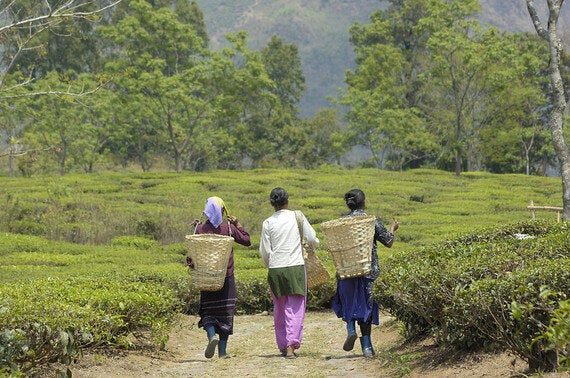
Fairtrade is a large, complex work in progress. We have never claimed to tackle all the many injustices that grind down people living in poverty, or to have achieved trade nirvana balancing all of global trade's problems with a magic Mark.
Rather we are gradually, layer by layer, unpeeling the intertwined and entangled impacts of poverty in trade. Every time we make progress, we uncover another problem, another issue screaming for attention.
We know Fairtrade is having an important impact for smallholder farmers and their communities, and for waged workers on Fairtrade plantations. We have never claimed to reach all the people living in abject poverty - for example the landless in city slums. We are working with smallholders growing quality cash crops for export: disadvantaged, yes; poorest in their country, no.
A growing body of academic research documents Fairtrade's contribution to a wide range of positive benefits for farmers, workers and communities across the regions and products where we work. For example, research in Uganda by Gottingen University into various certification schemes found that farmer incomes on the Fairtrade certified farms had risen by 30%.
Research undertaken in Asia, Africa and Latin America by Natural Resources Institute (NRI) found that "women and children had particularly benefitted from the Fairtrade Premium investments, including through building of more dispensaries, more classrooms, girls dormitories, water tanks and pipes, improved facilities and livelihood diversification activities."
We have made progress. But there is always the next layer of challenges waiting to be uncovered. Climate change is hitting farmers hard and their productivity is taking a nose-dive as the seasons spiral out of control. Or, as in recent years, the issue of how to effectively reach casual workers and migrant labourers on smallholder farms has come to the fore.
This May, a new study by SOAS throws the spotlight on those who work as temporary, occasional workers. Their research focused in particular on women who did not receive an education, are separated, divorced or widowed, who are forced to take whatever temporary jobs they can find in the countryside to survive.
The report provides snapshots into the lives of workers via interviews at selected sites in Ethiopia and Uganda, including areas in which three Fairtrade certified cooperatives are present.
It is worth pointing out that, while the research on non-certified farms covered workers on a variety of farm sizes and large plantations, the Fairtrade sites are all smallholder cooperatives, so the comparison is not like for like. In addition, the one Fairtrade certified plantation included in the study withdrew from certification shortly after the SOAS research was conducted, while the 'non-certified' Ethiopian flower plantation cited has in fact been Fairtrade certified since 2012.
SOAS' findings on the situation of workers they interviewed across the twelve sites are not surprising, but they are sobering. Agricultural wage workers are described as "desperately deprived" of education, diet, access and ownership (not even having basics such as a kerosene lamp), and casual workers are the most disadvantaged among them.
We agree with SOAS focusing global attention on these hidden workers. We recognize and appreciate the insights their research gives into the type and conditions of employment of vulnerable farm workers. We strongly disagree, however, with the wildly generalized and sensationalist conclusions SOAS has made about Fairtrade. Which is a shame as the research report itself is much more measured and useful.
Nevertheless, we hope that the SOAS data will help address this next big challenge - how to better reach temporary labourers and casual workers and ensure benefits of trade include them. It's not a challenge to Fairtrade alone. Far from it.
As their research shows, these workers are not benefitting from any intervention - trade unions have not reached them, nor have companies, nor governments, nor NGOs. So very practical and particular policy solutions will need to be found and the way is not easy.
In Fairtrade we have until now focused on how to improve conditions for smallholder farmers - 80% of the men and women in Fairtrade - and on workers on plantations. Now the challenge is to unpeel the next layer of the onion and further address poverty in trade: to consider the conditions of the casual, temporary workers on smallholder farms who help out, for example, at harvest.
How can we ensure that the benefits of Fairtrade reach them? If small-scale farmers are not earning enough to feed their families, how will they ever raise wages for the workers they hire?
For example, while in any smallholder cooperative there is a range of farms of different scale and size, we know on average Fairtrade coffee and tea smallholders in Africa have tiny plots of just 0.8 and 0.4 hectares respectively. That is less than a football pitch, from which to feed their family. They are highly vulnerable to price volatility and new threats from the changing climate.
And when they are only selling a low percentage of their crop on Fairtrade terms, there is simply little money to go around. For example, in 2011-12 when SOAS conducted their field research, one of the three Fairtrade cooperative sites they studied, Mpanga Tea Producers, sold less than 1% of its tea on Fairtrade terms.
So to improve the impact of Fairtrade for workers on small farms, we will have to do so in a way that supports the particularly vulnerable farmers who employ them. Driving the smallholders, who grow 70% of the world's food, out of business is not a solution. We have to find the right balance to obtain a win-win.
There are some things producers can do now. But to drive sustainable change there must be an end to rock bottom prices. Only if companies, and consumers, are willing to pay a little bit more for our goods, can farmers and workers have a dignified livelihood.
The Fairtrade Premium - extra funds that producers receive from their buyers to spur community and business investment - helps a lot. But it also brings tough choices, as needs are often much greater than the funds available. As workers or farmers meet at annual assemblies, they have to decide where their priorities lie.
Should they build an extra classroom for the school, or build housing in the hopes of attracting a teacher who will come to live in their isolated community so that students actually have regular lessons from a trained professional? Or is a road to link the farms to the community a better investment for everyone all around? These are not easy decisions for anyone to make. And it is certainly not for outsiders to dictate.
Another onion layer that we peeled away some years ago is the difficult issue of underage children working on smallholder farms. SOAS found that some children below the age of 15 were working for wages and long hours in regions with Fairtrade cooperatives.
Fairtrade farms are situated in and include some of the most socio-economic deprived and neglected areas of the world, where there are known high risks of child labour. In Sub-Saharan Africa one in five children between 5-17 years of age are involved in child labour, the highest rate in the world.
Rather than avoiding these areas, Fairtrade engages with these communities to tackle the problem. Fairtrade's rigorous auditing has at times identified child labour in farming operations and issued corrective actions, but we know policing alone will never eliminate the problem. Fairtrade producers must also become key agents of change so they themselves can identify and address unacceptable child labour practices.
We work with Fairtrade producers to train them on identifying the risks and support them to set up their own youth-inclusive, community-based monitoring and remediation systems on child labour, in partnership with child rights experts and/or NGOs where available.
All in all we hope that SOAS' study will be used to help people to understand the challenges that together we are up against, that Fairtrade is striving to tackle every single day.
The FAIRTRADE Mark does not mean that the product comes from a few hand-selected sites where conditions are perfect. It means that Fairtrade is working for a better deal alongside vulnerable farmers and workers as they tackle very real problems in their communities.
It means that with the engagement and support of companies and consumers, smallholders and workers can move forward on the long and rocky journey, step by faltering step, towards improving lives for themselves, their families and communities over time.
